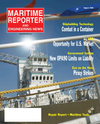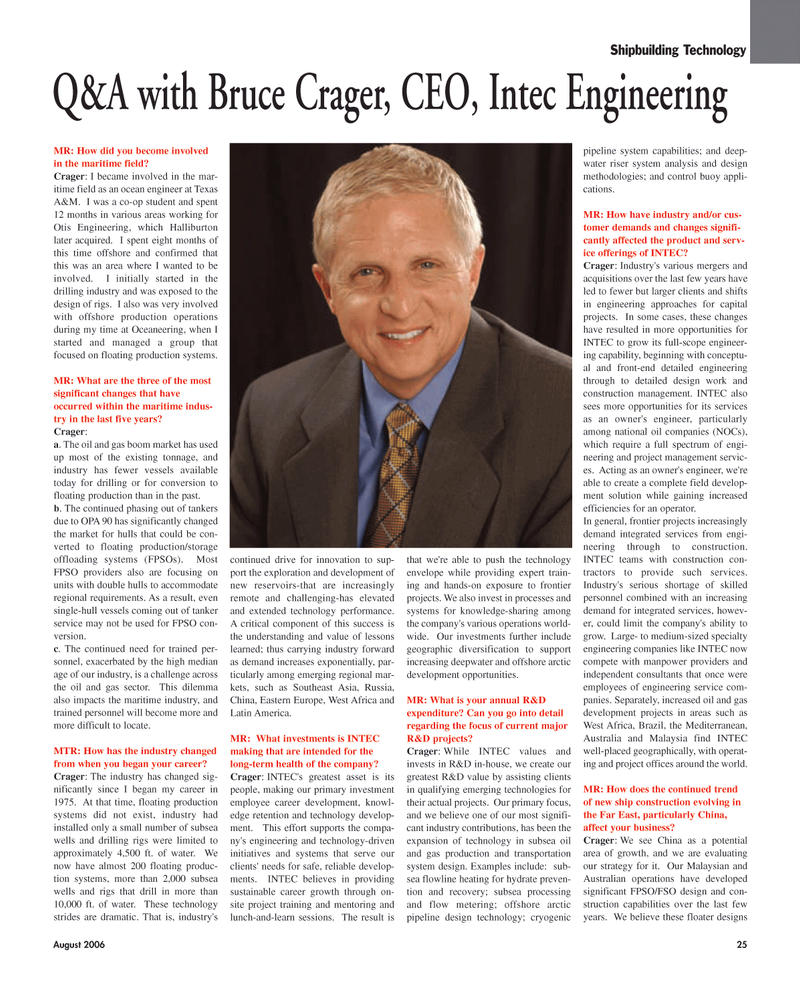
Page 25: of Maritime Reporter Magazine (August 2006)
AWO Edition: Inland & Offshore Waterways
Read this page in Pdf, Flash or Html5 edition of August 2006 Maritime Reporter Magazine
August 2006 25
MR: How did you become involved in the maritime field?
Crager: I became involved in the mar- itime field as an ocean engineer at Texas
A&M. I was a co-op student and spent 12 months in various areas working for
Otis Engineering, which Halliburton later acquired. I spent eight months of this time offshore and confirmed that this was an area where I wanted to be involved. I initially started in the drilling industry and was exposed to the design of rigs. I also was very involved with offshore production operations during my time at Oceaneering, when I started and managed a group that focused on floating production systems.
MR: What are the three of the most significant changes that have occurred within the maritime indus- try in the last five years?
Crager: a. The oil and gas boom market has used up most of the existing tonnage, and industry has fewer vessels available today for drilling or for conversion to floating production than in the past. b. The continued phasing out of tankers due to OPA 90 has significantly changed the market for hulls that could be con- verted to floating production/storage offloading systems (FPSOs). Most
FPSO providers also are focusing on units with double hulls to accommodate regional requirements. As a result, even single-hull vessels coming out of tanker service may not be used for FPSO con- version. c. The continued need for trained per- sonnel, exacerbated by the high median age of our industry, is a challenge across the oil and gas sector. This dilemma also impacts the maritime industry, and trained personnel will become more and more difficult to locate.
MTR: How has the industry changed from when you began your career?
Crager: The industry has changed sig- nificantly since I began my career in 1975. At that time, floating production systems did not exist, industry had installed only a small number of subsea wells and drilling rigs were limited to approximately 4,500 ft. of water. We now have almost 200 floating produc- tion systems, more than 2,000 subsea wells and rigs that drill in more than 10,000 ft. of water. These technology strides are dramatic. That is, industry's continued drive for innovation to sup- port the exploration and development of new reservoirs-that are increasingly remote and challenging-has elevated and extended technology performance.
A critical component of this success is the understanding and value of lessons learned; thus carrying industry forward as demand increases exponentially, par- ticularly among emerging regional mar- kets, such as Southeast Asia, Russia,
China, Eastern Europe, West Africa and
Latin America.
MR: What investments is INTEC making that are intended for the long-term health of the company?
Crager: INTEC's greatest asset is its people, making our primary investment employee career development, knowl- edge retention and technology develop- ment. This effort supports the compa- ny's engineering and technology-driven initiatives and systems that serve our clients' needs for safe, reliable develop- ments. INTEC believes in providing sustainable career growth through on- site project training and mentoring and lunch-and-learn sessions. The result is that we're able to push the technology envelope while providing expert train- ing and hands-on exposure to frontier projects. We also invest in processes and systems for knowledge-sharing among the company's various operations world- wide. Our investments further include geographic diversification to support increasing deepwater and offshore arctic development opportunities.
MR: What is your annual R&D expenditure? Can you go into detail regarding the focus of current major
R&D projects?
Crager: While INTEC values and invests in R&D in-house, we create our greatest R&D value by assisting clients in qualifying emerging technologies for their actual projects. Our primary focus, and we believe one of our most signifi- cant industry contributions, has been the expansion of technology in subsea oil and gas production and transportation system design. Examples include: sub- sea flowline heating for hydrate preven- tion and recovery; subsea processing and flow metering; offshore arctic pipeline design technology; cryogenic pipeline system capabilities; and deep- water riser system analysis and design methodologies; and control buoy appli- cations.
MR: How have industry and/or cus- tomer demands and changes signifi- cantly affected the product and serv- ice offerings of INTEC?
Crager: Industry's various mergers and acquisitions over the last few years have led to fewer but larger clients and shifts in engineering approaches for capital projects. In some cases, these changes have resulted in more opportunities for
INTEC to grow its full-scope engineer- ing capability, beginning with conceptu- al and front-end detailed engineering through to detailed design work and construction management. INTEC also sees more opportunities for its services as an owner's engineer, particularly among national oil companies (NOCs), which require a full spectrum of engi- neering and project management servic- es. Acting as an owner's engineer, we're able to create a complete field develop- ment solution while gaining increased efficiencies for an operator.
In general, frontier projects increasingly demand integrated services from engi- neering through to construction.
INTEC teams with construction con- tractors to provide such services.
Industry's serious shortage of skilled personnel combined with an increasing demand for integrated services, howev- er, could limit the company's ability to grow. Large- to medium-sized specialty engineering companies like INTEC now compete with manpower providers and independent consultants that once were employees of engineering service com- panies. Separately, increased oil and gas development projects in areas such as
West Africa, Brazil, the Mediterranean,
Australia and Malaysia find INTEC well-placed geographically, with operat- ing and project offices around the world.
MR: How does the continued trend of new ship construction evolving in the Far East, particularly China, affect your business?
Crager: We see China as a potential area of growth, and we are evaluating our strategy for it. Our Malaysian and
Australian operations have developed significant FPSO/FSO design and con- struction capabilities over the last few years. We believe these floater designs
Q&A with Bruce Crager, CEO, Intec Engineering
Shipbuilding Technology
MR AUGUST2006 #4 (25-32).qxd 8/2/2006 5:34 PM Page 25

 24
24

 26
26
